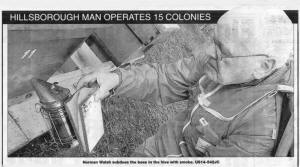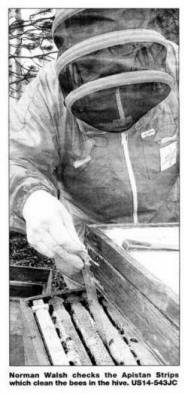HILLSBOROUGH MAN OPERATES 15 COLONIES

A HILLSBOROUGH man is currently beginning his third term as President of the Ulster Beekeepers Association.
Norman Walsh from Edentrillick Road, a member of the Dromore branch, was elected to the position recently at the Association's Annual General Meeting which took place at the Greenmount Campus of the College of Agriculture, Food and Rural Enterprise.
However, it will be the final time he will lead the organisation as no member can hold the post for more than three years.
Mr. Walsh explained his interest in beekeeping began more than 50 years ago when he was a student at the then Greenmount Agricultural College.
"I took the course in beekeeping along with my agriculture course," he explained.
"At that time the beekeeping course was compulsory for those studying horticulture but not for the agriculturalists. Nevertheless, I decided to study the subject.

"I started keeping my own bees around 1954 and I've been involved ever since - right through my student days, my working life and now in my retirement."
At present Mr. Walsh has 15 colonies of bees which produce honey right through spring and summer.
They even enjoy a summer holiday when all 15 hives are taken to the Mournes to allow the bees to produce heather honey. But how far do bees fly from their colony and how do they find their way back to their own particular hives after foraging for nectar and pollen?
Mr. Walsh explained that a young bee leaving the hive for the first time will thoroughly familiarise itself with the area. Each bee, he added, will fly up to three miles from the hive to get pollen and nectar.
"If you move the hives less than three miles when they go out they think they know the territory and will fly back to where the colony was originally located," he added.
"But when you move them further - for example when I take them down to the Mournes - they realise they know nothing.
"Really, if you're moving them you have to move them less than three feet or more than three miles."
Mr. Walsh has a fairly rapid turnover of bees as worker bees live for only about six weeks at the height of the season. However, the queen bee in each hive can lay up to 2000 eggs per day and so the colonies continue to flourish.
Unlike bumble bees or wasps which die off in winter the honey bees hibernate in their hives. "They form a ball inside the hive and the ones on the inside keep warm while the outside bees protect them," said Mr. Walsh.
"But by now they are starting to get out and about again gathering up pollen."
Mr. Walsh said by May there may be as many as 60,000 bees in each of his 15 colonies.
He also admitted he has been stung by his bees in the past.
"Bees die after they use their sting," he explained.
"They leave their stings in the skin and so rupture themselves."
But what happens to all the honey produced by these 15 colonies.
"I sell it and give it away," said Mr. Walsh. "I don't sell it through the shops, however. It just goes to people who call at the house."
07/04/2005

